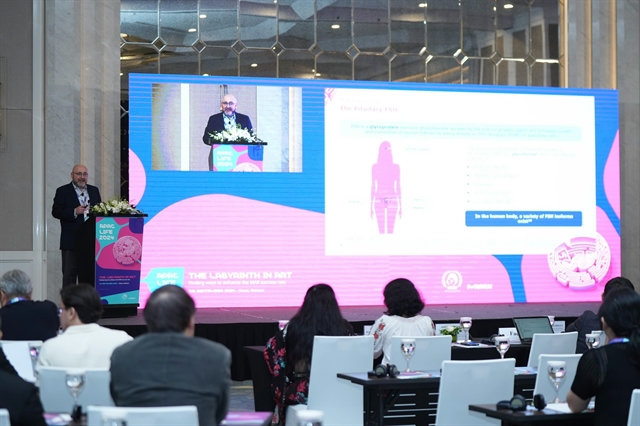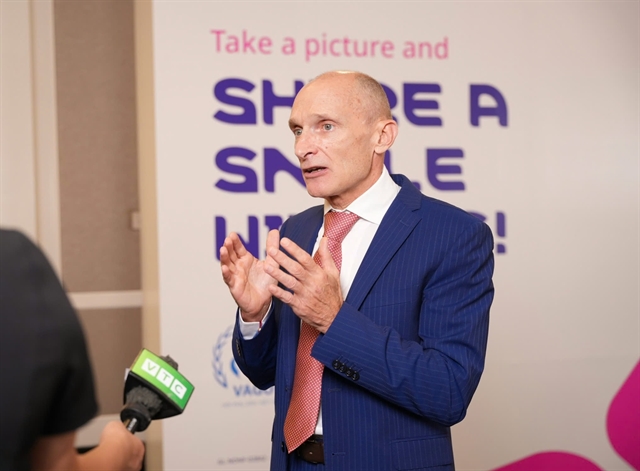 Society
Society

 |
| An international expert shares innovative solution to enhance the success rate of assisted reproduction at a symposium in Hà Nội on September 7. — Photo courtesy of the organiser |
HÀ NỘI — Health experts in reproductive health shared innovative solutions to enhance the success rate of assisted reproduction at a symposium in Hà Nội on September 7.
The two-day event was jointly organised by the Vietnam Association of Obstetricians and Gynaecologists and Merck Vietnam.
The symposium brought together over 1,000 global experts to discuss the latest advances in assisted reproductive technology (ART), covering topics like ovarian stimulation, individualised treatment, male infertility and fertility preservation. They also shared insights on the socioeconomic impact of fertility and updated reproductive health outcomes.
Speaking at the event, Prof. Nguyễn Viết Tiến, Former Deputy Minister of Health and Chairman of the Vietnam Association of Obstetricians and Gynaecologists, said: “Việt Nam faces a critical challenge with low fertility rates and high infertility rates. We need to explore effective interventions and support solutions to help individuals and couples achieve parenthood and enhance their quality of life.
This workshop will serve as a guide through the ART labyrinth, offering new directions and sharing the latest infertility treatments from global experts to advance our approaches to fertility care.”
Statistics from the Ministry of Health show that it is estimated that each year there are more than one million infertile couples in Việt Nam, equivalent to about 7.7 per cent, of which primary infertility is 3.9 per cent and secondary infertility is 3.8 per cent. Of these, about 50 per cent are couples under the age of 30. In particular, the rate of secondary infertility (infertility after one pregnancy) is increasing by 15-20 per cent each year and accounts for more than 50 per cent of infertile couples.
According to experts, ART is a rapidly evolving and complex field of medicine, to improve fertility and improve patient success rates. For those who are eager to start a family, choosing the right treatment can be difficult. ART includes a variety of methods, from in vitro fertilisation, and injection of sperm into soybean spores to freezing of eggs and embryos. Therefore, it is not easy for patients to find the right method to help them build their desired family in the maze with a series of potential treatments.
 |
| Senior Vice President of Merck Healthcare Asia Pacific Alexandre De Muralt speaks on the sideline of the symposium. — Photo courtesy of the organiser |
Senior Vice President of Merck Healthcare Asia Pacific Alexandre De Muralt said: “As the world's leading pharmaceutical company in infertility treatment, responsible for over five million IVF births - nearly half of all such births globally - Merck is acutely aware of the fertility challenges Việt Nam may face. Merck Healthcare Vietnam is continuously working towards adapting its solutions to Việt Nam's economic and social context, leveraging experiences and innovations from across the Asia-Pacific region to address key challenges in Vietnamese healthcare.”
The event is a forum to update specialised information on reputable assisted reproduction in Asia Pacific. The knowledge that experts share and exchange at this conference will make a significant contribution to improving reproductive health for patients in Việt Nam.
According to the Ministry of Health, the current population work still has many difficulties and challenges, typically the replacement fertility rate is not sustainable. Việt Nam's total fertility rate in 2023 is 1.95 children/woman, down from 2.01 children in 2022, below the plan of 2.1 replacement births, and is forecast to continue to decrease. The low birth rate has a direct and profound impact on the population structure, affecting the economy, labour, employment and social security. — VNS